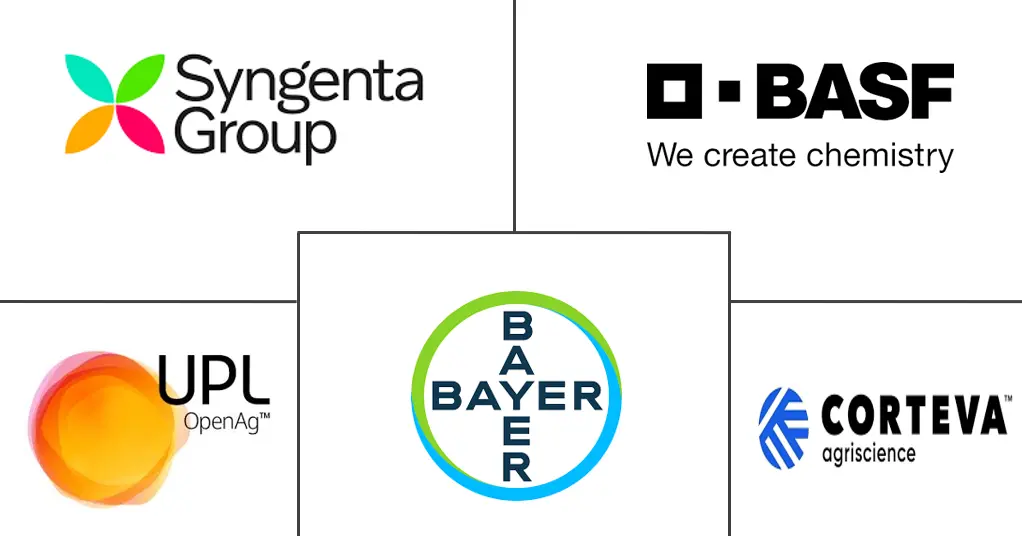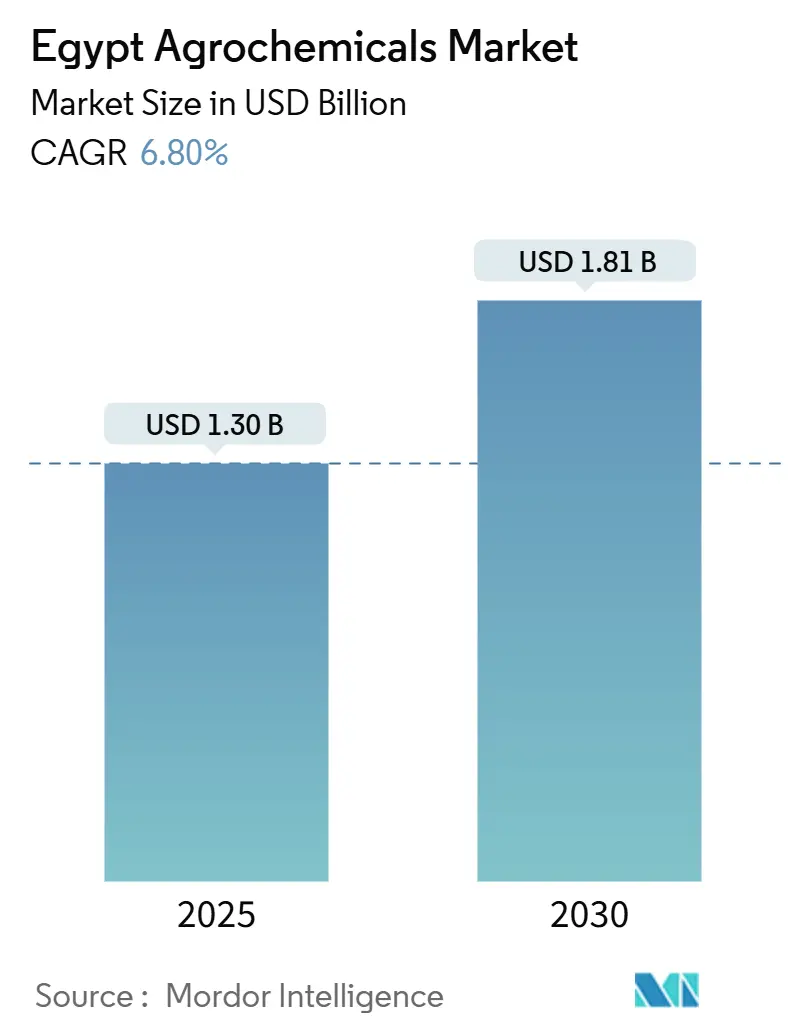
Egypt Agrochemicals Market Analysis by Mordor Intelligence
The Egypt agrochemicals market size is valued at USD 1.30 billion in 2025, and is projected to reach USD 1.81 billion by 2030 while advancing at a 6.8% CAGR during the forecast period. Sustained government financing for desert reclamation, the pivot toward climate-smart water management, and the transition from low-input subsistence farming to technology-enabled commercial agriculture are widening the need for yield-enhancing fertilizers, and adjuvants. Input demand is also responding to structural shifts in crop mix as farmers chase export rebates on high-value horticulture and herbs, while mounting energy-price volatility is accelerating a parallel move into green ammonia and alternative nutrient sources. The sector’s labor-intensive agriculture still employs 28% of Egypt’s workforce, further magnifying the socio-economic stakes tied to a reliable flow of competitively priced inputs. Multinational suppliers have deepened local joint ventures, yet domestic incumbents retain scale advantages under a state-backed fertilizer allocation system that prioritizes food-security objectives.
Key Report Takeaways
- By product type, fertilizers led with 57.2% revenue in 2024 of the Egypt agrochemicals market share, while adjuvants are forecast to expand at an 8.1% CAGR through 2030.
- By crop type, grains and cereals captured 43.0% of the Egypt agrochemicals market size in 2024, while fruits and vegetables are projected to grow at a 6.8% CAGR to 2030.
Egypt Agrochemicals Market Trends and Insights
Drivers Impact Analysis
| Driver | (~)% Impact on CAGR Forecast | Geographic Relevance | Impact Timeline |
|---|---|---|---|
| Decreasing arable land driving yield-intensive inputs | +1.2% | National, concentrated in Nile Delta and newly reclaimed areas | Medium term (2-4 years) |
| Surge in desert-reclamation megaprojects | +1.8% | National, focused on Western Desert, Sinai, and Upper Egypt | Long term (≥ 4 years) |
| Rapid adoption of fertigation and liquid fertilizers | +1.1% | National, with higher penetration in commercial farms | Short term (≤ 2 years) |
| Government export-rebate program for value-added crops | +0.9% | National, with emphasis on export-oriented regions | Medium term (2-4 years) |
| Pivot to climate-smart drip-ready nutrient blends | +0.7% | National, particularly in water-scarce regions | Medium term (2-4 years) |
| Satellite-enabled pest-pressure alerts | +0.5% | National, with early adoption in large-scale operations | Short term (≤ 2 years) |
| Source: Mordor Intelligence | |||
Decreasing Arable Land Driving Yield-Intensive Inputs
Less than 5% of Egypt’s land is cultivable. Urban encroachment into fertile Delta soils continues, pushing average arable land per capita below 0.1 hectare. Investment of EGP 116.6 billion (USD 3.9 billion) in 2024 under the national medium-term plan prioritized controlled-release fertilizers, micronutrient blends, and salt-tolerant seed varieties capable of sustaining yields in increasingly saline conditions. Soil analyses show 64% of samples in the northeastern Delta are strongly saline and highlight irrigation-water quality as a severe yield constraint. These pressures are funneling demand toward high-efficiency macronutrient solutions that reduce run-off and improve uptake efficiency.
Surge in Desert-Reclamation Megaprojects
Projects such as Toshka Al-Khair, targeting 1 million feddans with an investment of EGP 6.4 billion or USD 213 million, and the New Delta’s “Egypt’s Future”, spanning 2.2 million feddans, are recasting the spatial map of Egyptian agriculture[1]Source: Egyptian State Information Service, “Toshka Al-Khair Project,” sis.gov.eg. These megaprojects are fundamentally altering input demand patterns, as desert soils require intensive soil conditioning, specialized nutrient formulations, and water-efficient application methods that differ markedly from traditional Nile Delta farming practices. Desert soils require gypsum and trace-element packages to counter micronutrient lock-out. Water infrastructure drilled by Zhongman Petroleum, including more than 680 wells, underpins these schemes and cements a long-term pull for drip-compatible soluble fertilizers.
Rapid Adoption of Fertigation and Liquid Fertilizers
Shifting 6.6 billion m³ of irrigation water from flood to drip could be achieved through fertigation, enhancing nutrient-use efficiency and curbing leaching losses. This growth trajectory reflects the superior efficiency of liquid fertilizers in drip irrigation systems, where nutrients can be delivered directly to plant root zones with minimal waste and maximum uptake rates. The adoption of fertigation technology is particularly pronounced in Egypt's desert reclamation projects, where water conservation is paramount and traditional broadcasting methods prove inefficient. Research shows ten-cycle nitrogen fertigation schedules raise canola yields and water productivity relative to conventional six-cycle regimes. Demand for low-salt liquid formulations that flow smoothly through emitters is therefore accelerating, particularly in Western Desert commercial pivots.
Government Export-Rebate Program for Value-Added Crops
Export rebates of EGP 30 billion (USD 1 billion) in FY 2023/24 and a planned rise to EGP 60 billion (USD 2 billion) by 2025 push growers toward premium horticulture. Medicinal-herb acreage is scheduled to double to 250,000 acres, amplifying demand for fertilizers and crop-protection agents that meet strict residue profiles in destination markets. The export rebate program is catalyzing demand for premium input solutions and quality-enhancing additives that can help Egyptian agricultural products meet stringent international standards. Agricultural exports currently constitute 30% of Egypt's total exports, with the government's Export Development Fund implementing targeted programs to support various sectors while addressing export bans and improving market access.
Restraints Impact Analysis
| Restraint | (~)% Impact on CAGR Forecast | Geographic Relevance | Impact Timeline |
|---|---|---|---|
| Stricter residue-tolerance limits in EU export markets | -0.8% | National, particularly affecting export-oriented farms | Short term (≤ 2 years) |
| Fuel-price-linked ammonia cost volatility | -1.2% | National, concentrated in fertilizer-intensive regions | Short term (≤ 2 years) |
| Counterfeit pesticide trade via informal channels | -0.6% | National, with higher impact in rural areas | Medium term (2-4 years) |
| Rising salinity-induced micronutrient lock-out | -0.9% | Concentrated in Nile Delta and coastal regions | Long term (≥ 4 years) |
| Source: Mordor Intelligence | |||
Stricter Residue-Tolerance Limits in EU Export Markets
Egypt’s National Food Safety Authority aligned maximum residue limits with EU thresholds, yet historic sampling of vegetable consignments shows 13% exceeded those limits[2]Source: MDPI, “Nationwide surveillance of pesticide residues in Egyptian vegetables,” mdpi.com. The compliance burden boosts demand for precision application tools while penalizing broad-spectrum chemistries. The Egyptian government's response includes the launch of a CropLife-backed Sustainable Pesticide Management Framework in October 2024, aimed at enhancing pesticide management practices and ensuring compliance with international standards. This regulatory pressure is driving increased demand for control agents and precision application technologies that can minimize residue risks while maintaining crop protection efficacy.
Fuel-Price-Linked Ammonia Cost Volatility
Natural gas feeds 75-80% of nitrogen-fertilizer costs. A gas-supply cut in 2024 drove urea bag prices. The Ministry of Petroleum's decision to reduce natural gas supplies to fertilizer companies to conserve energy for electricity production highlights the competing demands for limited energy resources, creating ongoing uncertainty for input pricing and availability. Producers such as Misr Fertilizers Production Company (MOPCO) now partner with thyssenkrupp on carbon-capture and green-ammonia units designed to de-risk feedstock exposure.
Segment Analysis
By Product Type: Fertilizers Dominate Amid Precision Shift
Fertilizers captured 57.2% of the Egypt agrochemicals market in 2024, with nitrogen forms prevailing in traditional Delta soils while sulfur-containing compounds and micronutrient cocktails underpin desert cultivation. Delta Fertilizer’s revamp will raise daily urea output to 2,250 metric tons, trimming steam use by 35%. Adjuvants, though smaller, are the fastest-growing slice, propelled by the need to enhance droplet adhesion in hot, arid conditions. Pesticides retain consistent demand as horticulture acreage expands, yet plant-growth regulators are gaining share where residue limits and drought stress converge.
Adjuvants are forecast to expand at an 8.1% CAGR through 2030. Growing reliance on fertigation unlocks premium for chloride-free potassium nitrate and low-pH phosphorus acids tailored for drip systems. Meanwhile, the Egypt agricultural inputs industry is steering R&D toward coatings that modulate nutrient release when soil thermometers top 40 °C, now a regular summer reality in inland reclamation zones. Domestic fertilizer makers increasingly court to insulate against gas-price shocks, with MOPCO’s planned 150,000 metric tons green-ammonia unit positioning Egypt as a possible export hub for low-carbon nutrients.
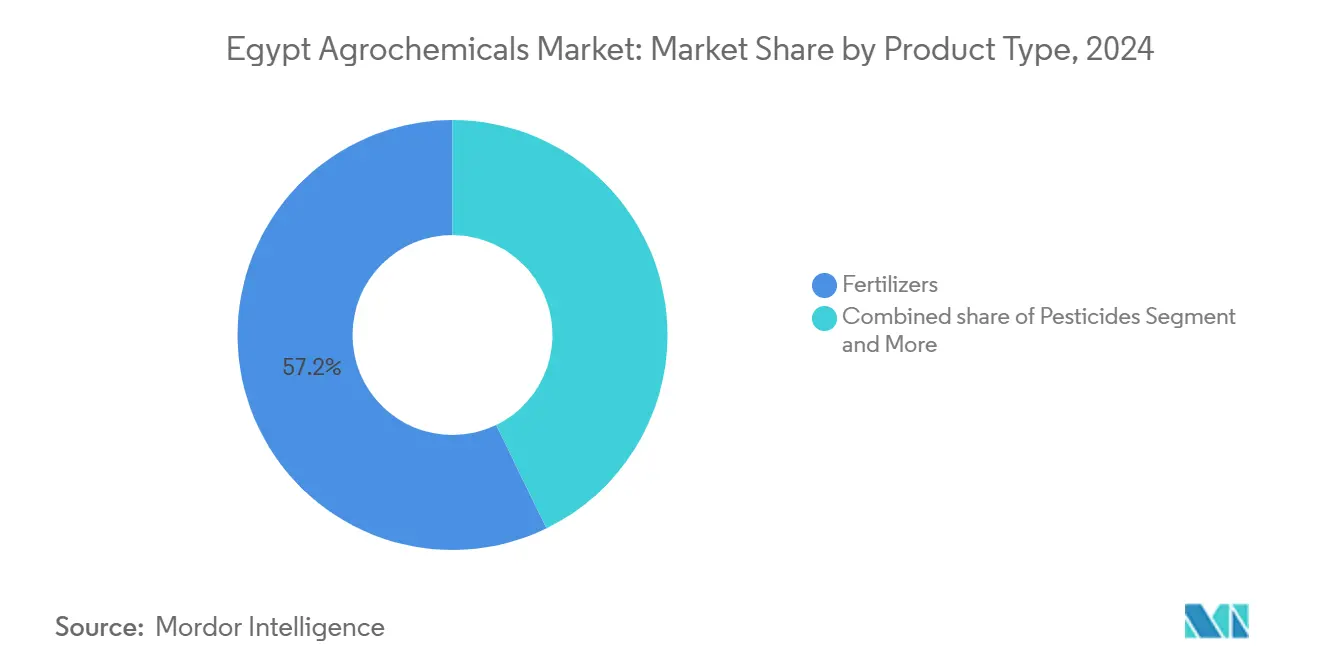
Note: Segment shares of all individual segments available upon report purchase
By Crop Type: Cereals Lead While Horticulture Accelerates
Grains and cereals commanded 43.0% of market value in 2024 as policymakers target wheat self-sufficiency amid global trade disruptions. The Egypt agrochemicals market size for cereals is forecast to grow 5.1% CAGR to 2030, aided by government seed subsidy schemes and the integration of remote-sensing analytics that optimize nitrogen top-dressing windows. Simultaneously, fruits and vegetables spanning table grapes, citrus, and medicinal herbs are poised for a 6.8% CAGR, reflecting rebate-driven acreage shifts. Pulses and oilseeds extend moderate growth as rotation crops that buffer soil fertility.
Precision agriculture’s march into horticulture has raised demand for adjuvants and specialty fertigation blends that meet stringent export grades. The Egypt agrochemicals market share for horticulture inputs rose two points in 2024 and is projected to be the fastest mover through 2030. Import-dependent segments such as turf and ornamentals likewise benefit from urban landscaping tied to the New Administrative Capital, though their aggregate weight remains below 5% of sector turnover.
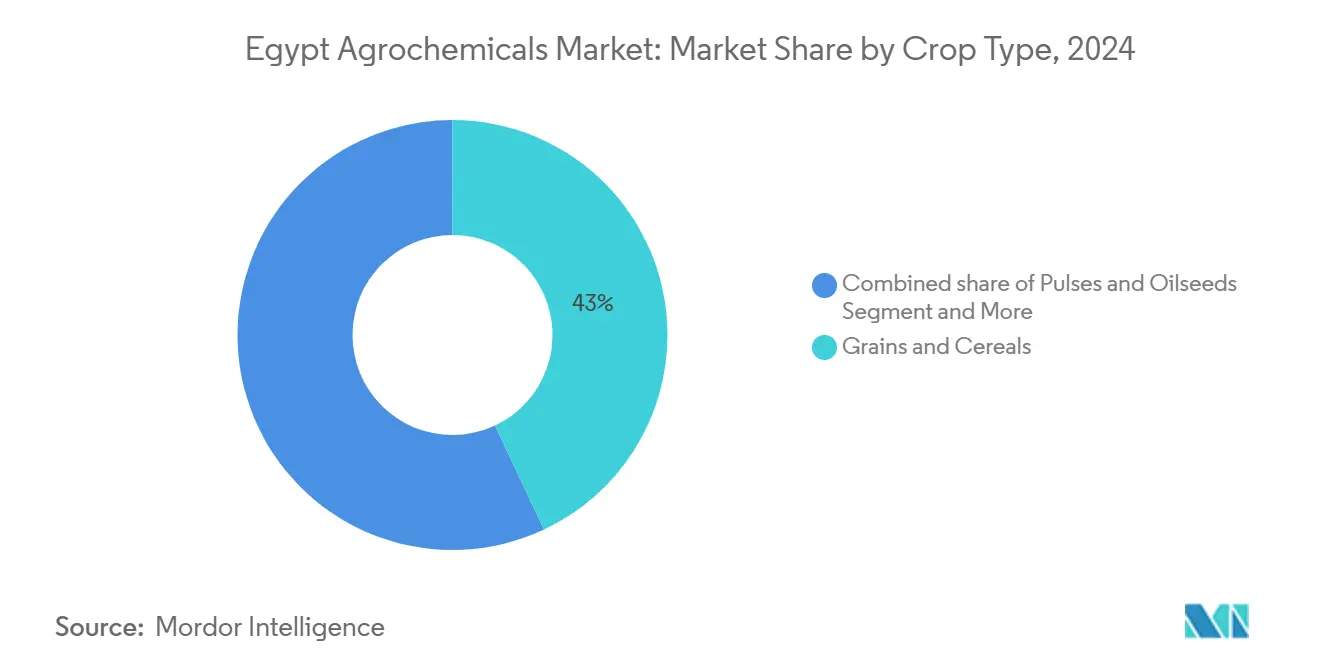
Note: Segment shares of all individual segments available upon report purchase
Geography Analysis
The Nile Delta and Valley still account for more than two-thirds of total input sales, yet Western Desert growth corridors are now setting the pace with double-digit annual expansion. Soil-salinity mapping shows 87.5% of irrigation-water samples in the northeastern Delta fall in classes that severely constrain production, elevating demand for gypsum, elemental sulfur, and chelated micronutrients. Upper Egypt’s Luxor-Aswan belt gains strategic significance as large-scale irrigation grids reach newly cultivated plots, facilitated by public-private investment in pump stations and subsurface drip irrigation.
Western Desert megaprojects, including Toshka and the New Delta cluster, collectively target over 3 million feddans by 2030. These schemes preferentially deploy climate-resilient wheat, maize, and oilseed varieties alongside drip-tailored nutrient blends. The Egypt agrochemicals market has therefore witnessed an east-to-west reshuffle of warehouse footprints and distributor networks. Sinai, while smaller, presents an early-stage opportunity tied to 17 new agricultural development clusters aimed at integrating Bedouin communities and export-oriented herb cultivation.
Groundwater quality dictates differentiated input strategies. GIS-based assessments in Wadi Qena show total-dissolved-solid concentrations above 3,000 mg/L, suitable only for salt-tolerant crops without advanced treatment. Vendors therefore market sulfuric-acidified fertigation packages that buffer pH and counter salt stress. In the Nile Valley, emerging aquifer depletion risks are generating demand for water-holding soil polymers and biostimulants that mitigate drought impact.
Competitive Landscape
The Egypt agrochemicals market exhibits moderate fragmentation, and the combined market share of the top five suppliers constitutes nearly 45%. Multinationals differentiate via digital agronomy portfolio, while domestic producers leverage subsidized gas allocations and geographic proximity. Syngenta Group’s Cropwise roll-out across 220,000 acres in partnership with Al Dahra exemplifies the melding of big-data tools with local field operations[3]Source: Syngenta, “Data is revolutionizing agriculture by enabling better decisions,” syngenta.com. BASF SE’s Mobile Agricultural Clinic, which has served 5 million smallholders, embeds advisory services that secure brand loyalty in a price-sensitive segment.
Domestic champions such as Abu Qir Fertilizers advance green-hydrogen pilots to decarbonize urea output and hedge feedstock cost swings. MOPCO’s carbon-capture retrofits, capable of sequestering 145,000 metric tons CO₂ annually, signal state intent to anchor a regional green-ammonia export platform. On the crop-protection front, regulatory tightening encourages portfolio shifts toward low-residue actives; suppliers with advanced R&D pipelines stand to gain share as EU standards tighten.
Technology adoption is the new battleground. Field studies indicate a 75% uptake probability for subsurface drip under high water-cost scenarios, driving bundled sales of pressure-compensated emitters and fertigated nutrient blends. As retailers integrate satellite diagnostics and mobile e-commerce, last-mile reach into Upper Egypt and New Valley zones is improving, narrowing the service gap for smallholders.
Egypt Agrochemicals Industry Leaders
-
BASF SE
-
Bayer CropScience Ltd.
-
UPL Limited
-
Corteva Agriscience
-
Syngenta Group Co., Ltd.
- *Disclaimer: Major Players sorted in no particular order
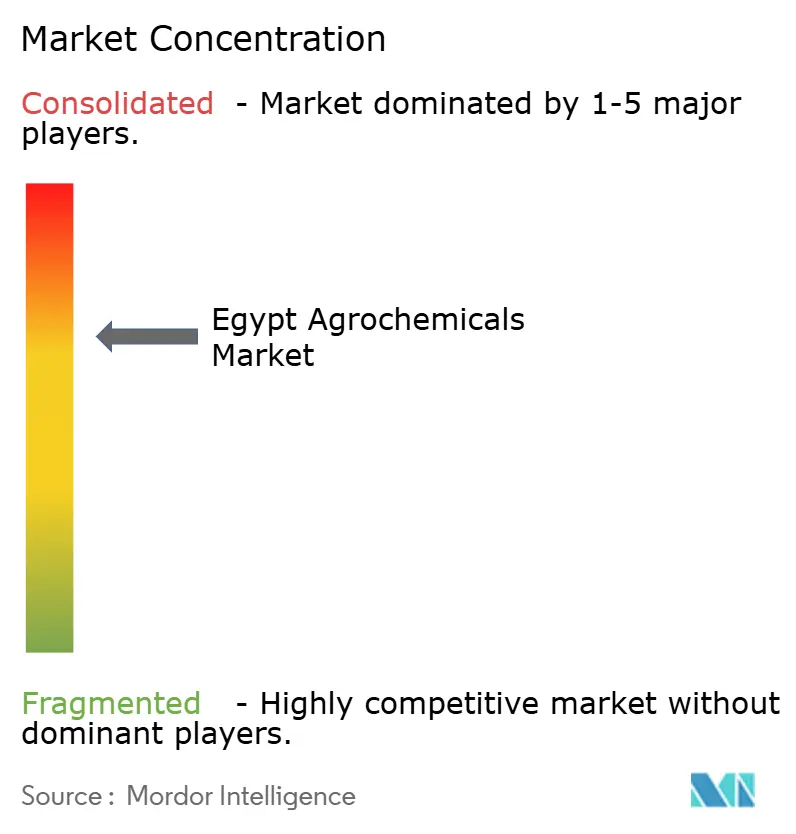


Recent Industry Developments
- May 2025: Syngenta and Al Dahra deployed Cropwise Operations over 220,000 acres across Egypt, Romania, Serbia, and Morocco, embedding real-time agronomic analytics.
- March 2025: Egypt’s Agriculture Ministry signed a soil-fertilizer plant deal with Saudi Green Company for Agricultural Development in Nubaria. Production starts in June 2025.
- July 2024: The Misr Fertilizers Production Company (MOPCO) partnered with Scatec, a Norwegian Company, to build a green ammonia production plant that produces 150 thousand metric tons in Damietta, Egypt. The Egyptian government supported the project and invested USD 10 million.
Egypt Agrochemicals Market Report Scope
Agrochemical refers to biocides (pesticides including insecticides, herbicides, fungicides, and nematicides) and synthetic fertilizers. It may also include hormones and other chemical growth agents.
The Egyptian agrochemicals market is segmented by product type (fertilizers, pesticides, adjuvants, and plant growth regulators) and application (crop-based and non-crop-based). The report offers market size and forecast values (USD) and volume (metric tons) for all the above segments.
| Fertilizers |
| Pesticides |
| Adjuvants |
| Plant Growth Regulators |
| Biostimulants |
| Grains and Cereals |
| Pulses and Oilseeds |
| Fruits and Vegetables |
| Turf and Ornamentals |
| By Product Type | Fertilizers |
| Pesticides | |
| Adjuvants | |
| Plant Growth Regulators | |
| Biostimulants | |
| By Crop Type | Grains and Cereals |
| Pulses and Oilseeds | |
| Fruits and Vegetables | |
| Turf and Ornamentals |


Key Questions Answered in the Report
How large is the Egypt agrochemicals market in 2025?
The market is valued at USD 1.30 billion in 2025, with a 6.8% CAGR forecast to 2030.
Which product category generates the highest revenue?
Fertilizers lead with 57.2% of revenue in 2024, driven by nutrient demands in both Delta and desert soils.
What segment is expanding the fastest?
Adjuvants are projected to grow at an 8.1% CAGR from 2025 to 2030 as precision spraying gains traction.
How are export rebates influencing input demand?
Rebates totaling EGP 30 billion (USD 1 billion) in FY 2023/24 are steering farmers toward high-value horticulture that requires specialty fertilizers and biological crop protection.
Why are green-ammonia projects gaining momentum?
Volatile natural-gas pricing and rising carbon-compliance costs are prompting producers to invest in carbon-capture and renewable hydrogen pathways to stabilize fertilizer supply.
Page last updated on:
